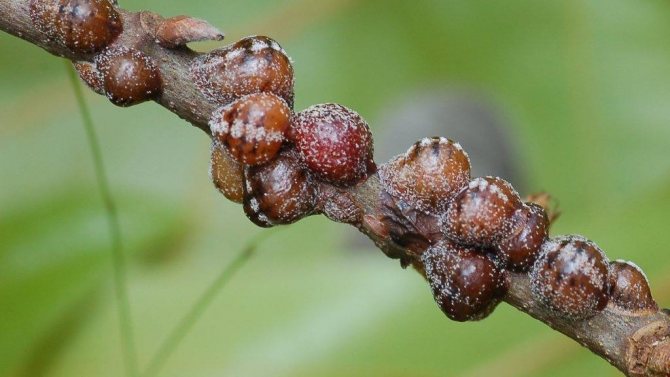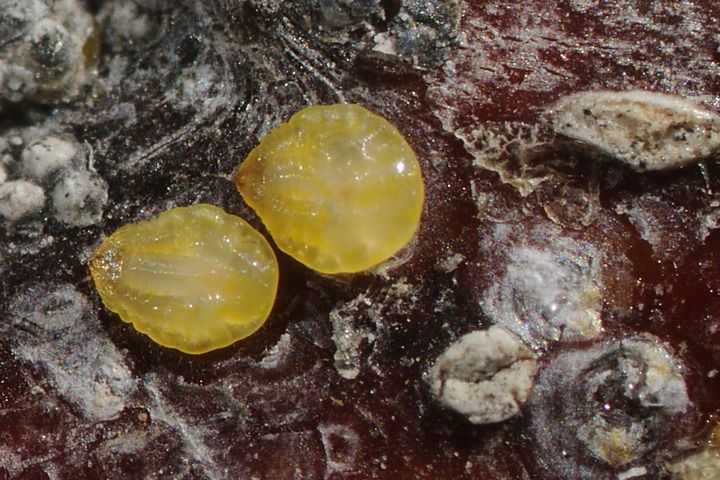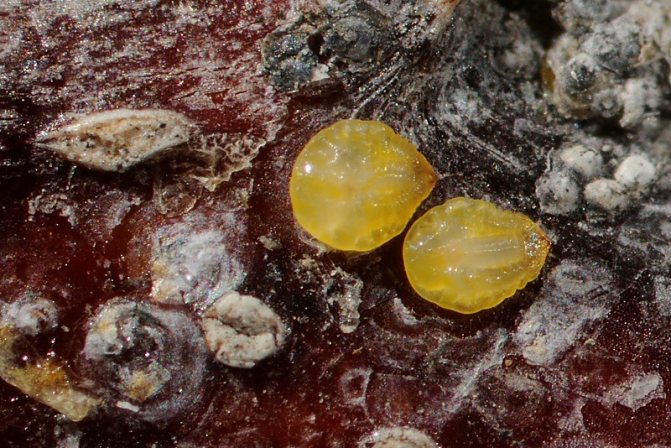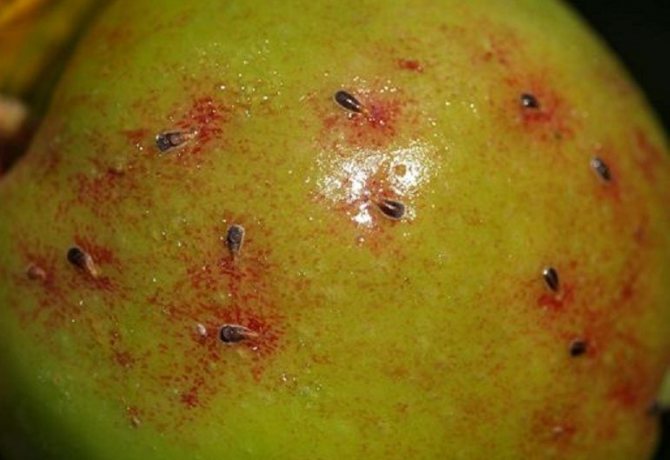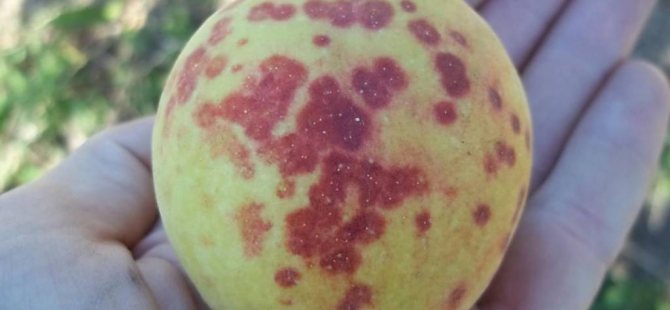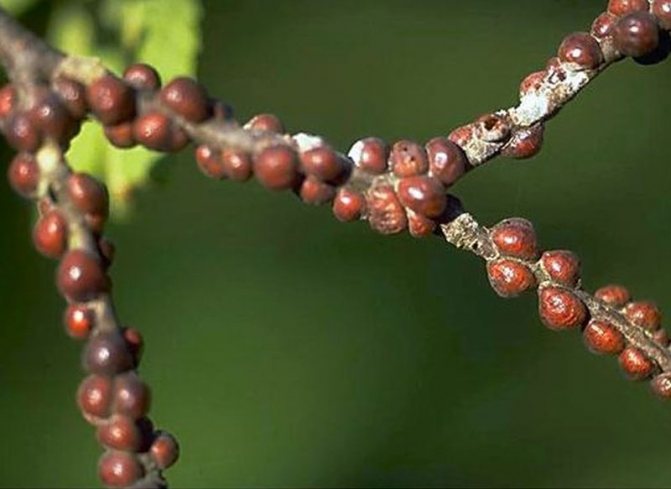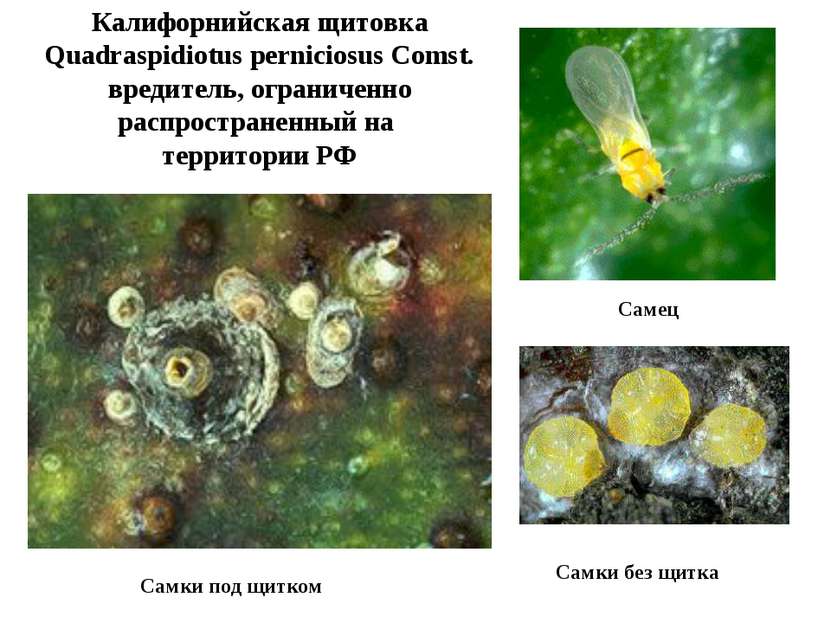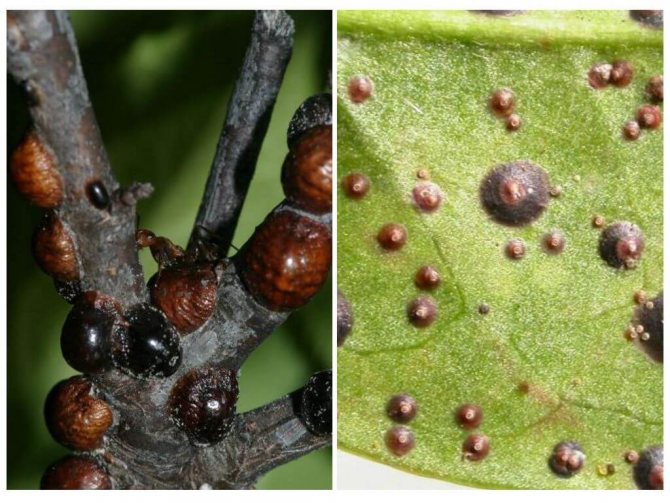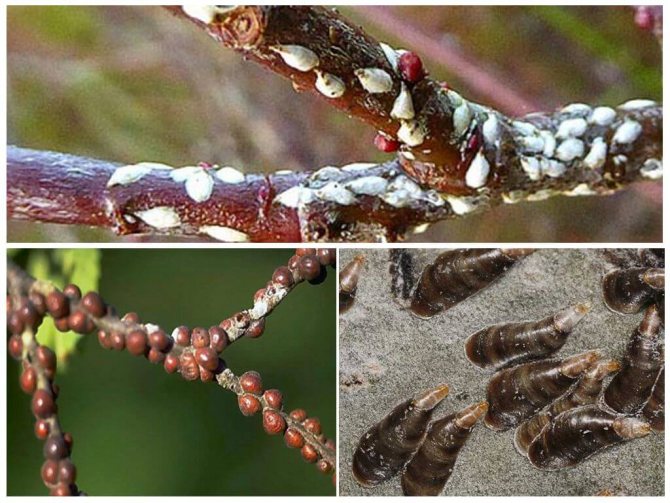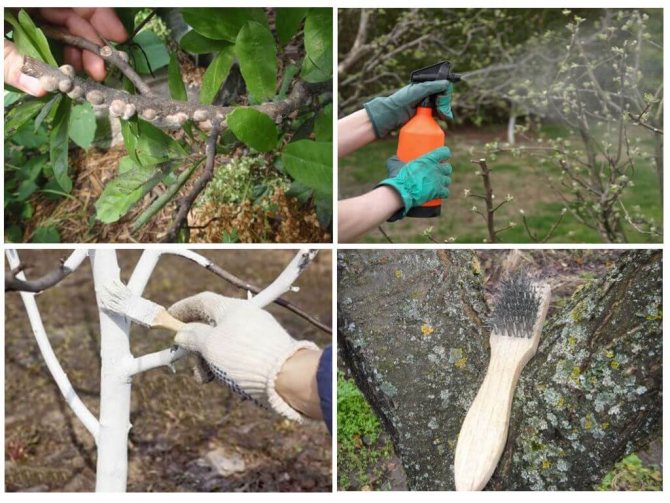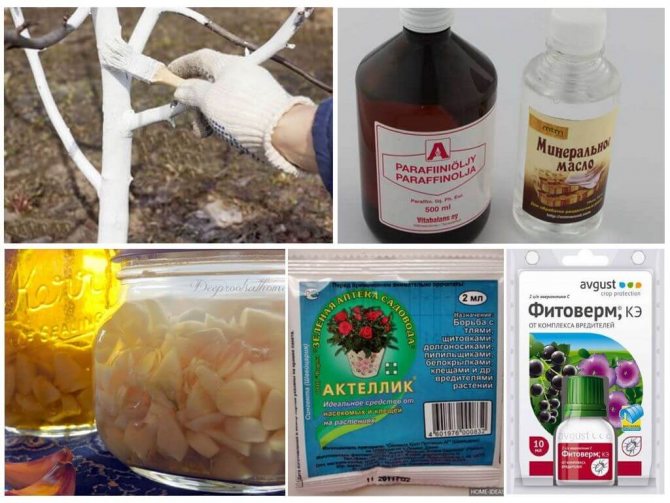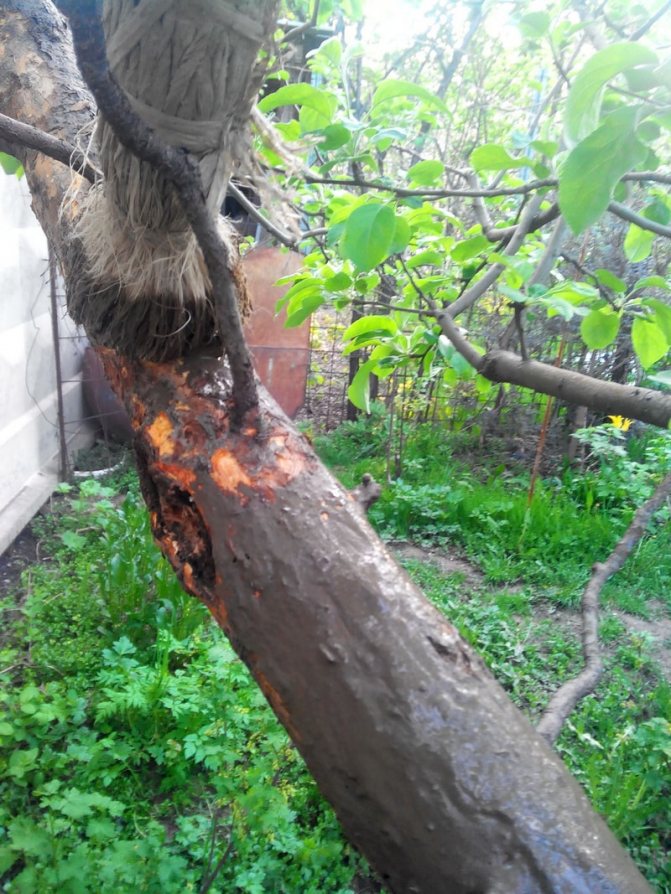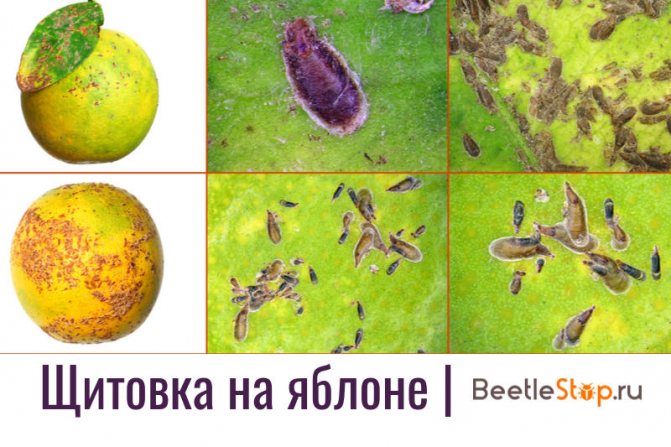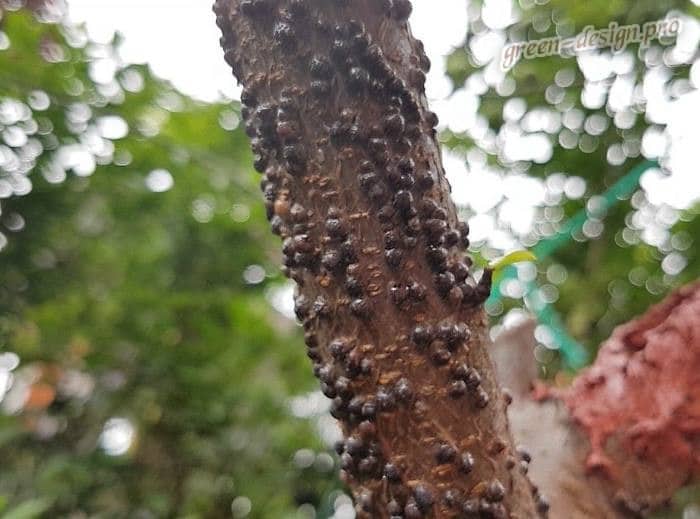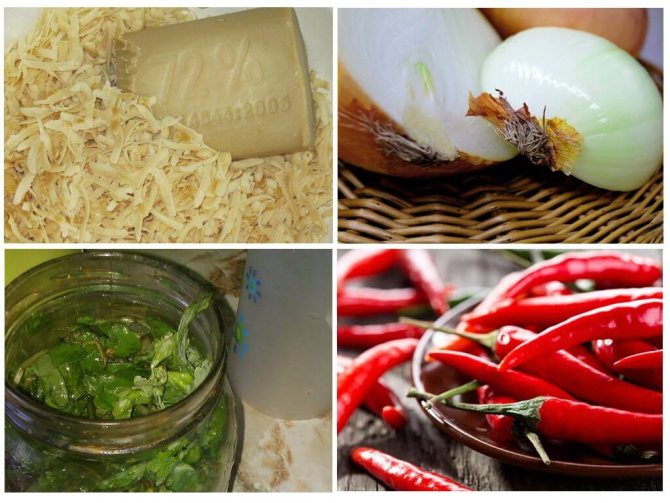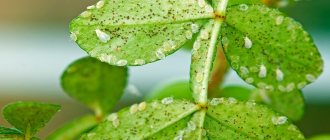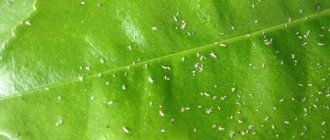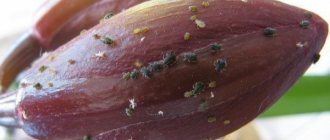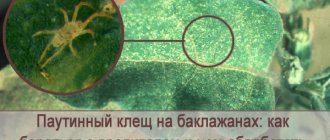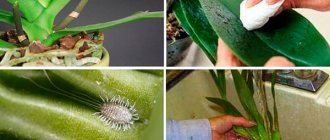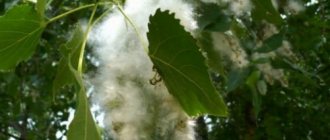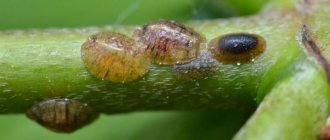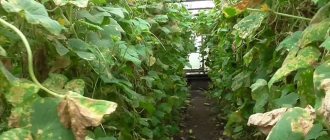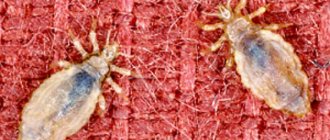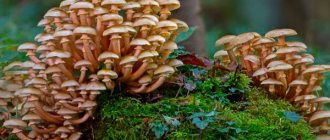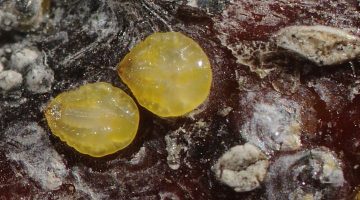
The California scale insect is a very harmful insect. After all, it parasitizes on one and a half hundred varieties of cultivated plants. In our conditions, the scabbard causes the most harm to fruit trees. Insects can be found on apple, cherry, pear, etc. Moreover, this pest affects leaves, branches, and even tree trunks. Naturally, not a single gardener will put up with the destruction of their green spaces. But before discussing how to deal with this pest, it is worth getting to know him better.
Types of garden shields
There are several thousand varieties of scale insects. But they prefer to live on those plants that are grown in greenhouses or rooms. Only a few varieties live on plants that are grown outdoors.
The most common scabies are:
- Californian. They are small, round, inconspicuous, gray-brown, and mature males are orange. Their impact begins imperceptibly, and after a few years whole settlements are visible in the form of spots of red-brown color;
- mulberry. Females of this subspecies are slightly larger than males, whitish-yellow, and the male sex is smaller, but with antennae and wings. This subspecies often affects fruits, making them unusable;
- purple. The shade is the same for both sexes, the size of the males is smaller. They settle mostly on the vein of leaves, which is why they become discolored. Brown-purple spots also appear on the fruit;
- apple comma-shaped. It is named so because of the shape of the calf, in the form of a pear. Females are brownish, and males are slightly redder, with wings and a long process for feeding. Mostly young shoots are affected;
- oyster. Short oval pests with a flattened center. Males appear slightly brighter than females with an orange tint. They are located most often on the lower parts of the leaves.
Most often, these subspecies are found in the garden. The methods of dealing with them are identical.
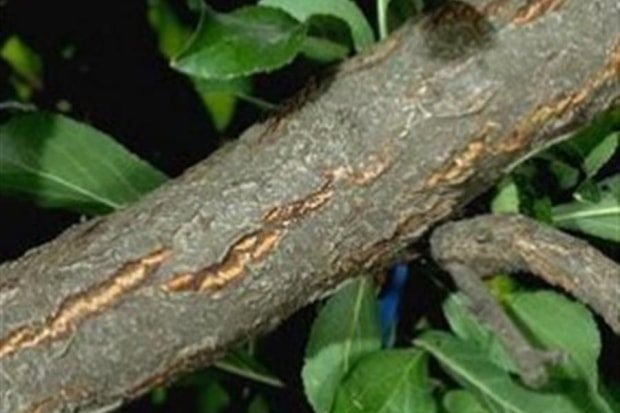

Californian scale insect on the trunk of an apple tree.
What harm does the scabbard cause?
The California scale insect is absolutely unpretentious in nutrition. The rapid growth of the population and active reproduction are also facilitated by the absence of natural enemies. That is why the insect has taken root well in American and European gardens.
Scabbards are located in numerous colonies on the branches, fruits and leaves of cultivated plants. In the process of development, the larvae suck the sap from the trees, which leads to cracking and death of the bark. Depletion of plants impedes their growth, causes deformation and a decrease in fruit.
Trees affected by large colonies of scale insects often lose their ability to produce crops, since the main reserves of nutrients are used to restore the structure of leaves and bark.
The fight against the Californian scale insect is extremely important, since plants affected by the pest die even in mild frosts. Actions aimed at protecting fruit trees are taken at the beginning of March, when the plants have not yet formed buds.
How to identify plant damage
There are a number of symptoms by which you can determine the infection of the apple tree with a scabbard:
- The appearance of honeydew or honeydew - sticky syrup on the branches.
- The spread of soot fungus.
- The appearance of grayish or brownish plaques on the bark.
- Over time, they will become palpable bumps.
- The leaves turn red and die off.
The presence of these signs indicates a disease of the apple tree. If you ignore them, then the plant will eventually stop developing altogether. You need to fight the pest immediately so that the scabbard cannot do much damage.
External signs of defeat
The first sign of damage by scabies can be considered the appearance on the leaves of whitish convex spots and outgrowths, which are difficult to separate from the surface.
The leaves become covered with pad (sticky liquid), lose their shine, bald spots and black spots appear on the damaged areas. Scabbards create colonies near the junctions of branches with the trunk and on the underside of leaves.
Another sign is bark cracking. In addition, such cracks are excellent shelters for scale insect larvae.
Preventive control measures
There are several preventive measures that can help keep your garden healthy. These include:
- timely thinning of the crown;
- pruning and removal of tops, fattening shoots and dry growth;
- cleaning the bark from dry parts;
- proper watering and fertilization to boost immunity.
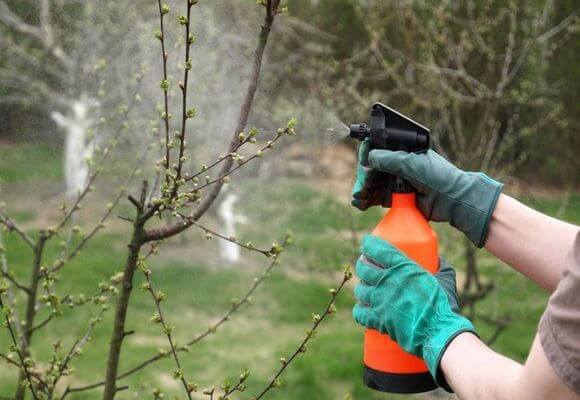

Spraying apple trees from pests.
No disease occurs on a healthy tree.
Reasons for infection and prevention
Most often, the scale insect enters the garden with contaminated planting or grafting material. The larvae can be carried by birds, and the mulberry scale can even be carried by the wind.
Therefore, when buying young seedlings or cuttings for grafting, carefully examine them. And in the future, conduct a systematic survey of the garden, pay attention to the change in the appearance of plants. For example, if there are red dots on the fruits, then it must be urgently examined, a Californian scabbard may be found.
The main preventive measures are:
- crown thinning:
- timely removal of dried and damaged branches, dead trees, root growth;
- cleansing of damaged and lagging bark on boles and skeletal branches;
- correct watering and application of the necessary fertilizers, since a strong plant is more resistant to pest attacks.
Pest control in various ways
Insects have a shield that protects the scabbard from various influences. But a set of measures aimed at defeating the pest can be effective.
Among them:
- mechanical removal of a small settlement using a swab moistened with alcohol;
- folk methods that act on young individuals. These are different infusions and decoctions;
- biological, the use of entomophages and fungicides;
- chemical, strong insecticides.
But, using any methods of struggle, it is necessary to take into account the life cycle of the scabbard, because at a certain moment, when it is covered with a shell, almost all actions will be ineffective.
How to treat an apple tree from pests
In order for the apple trees to be healthy and enjoy a bountiful harvest, it is important to prevent viruses, diseases and insect pests from spreading.
In order to get rid of pests that damage apple trees, there is a whole range of measures. Pests are fought with agrotechnical and mechanical methods, as well as with the help of poisonous mixtures. Insecticides can only be purchased from specialized stores.
It is necessary to use poison, strictly observing its dosage and following the instructions for use. If there is not enough information about the drug in the instructions, you can find it on the Internet. If there are not many pests, you can first try to deal with them using folk methods. And only if this does not work, switch to chemical methods of struggle.
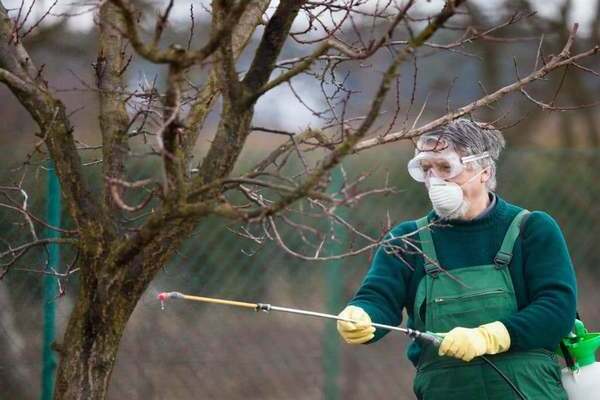

Weeds are removed between the rows of apple trees.To get rid of insect pests, trapping belts and traps are hung on the trees, and mulch is laid on the soil around them. All pest-infested branches and leaves are cut and burned without delay.
Pest control begins after the apple trees have faded. Apple trees are treated twice a season for ticks. If an apple sawfly appears, then the trunks and branches must be treated with preparations that include chlorophos.
For scab, apple trees are treated with a Bordeaux mixture three times with intervals of three weeks between them. Regularly you need to inspect apple trees for the appearance of a white web. This is the first sign of caterpillar infestation. If aphid colonies appear on the branches, then they need to be broken off and burned.
Pest control tips from gardeners
In this collection, there are several tips from professional agricultural technicians and gardeners who have already encountered a shield on an apple tree, and how to deal with it, they already know:
- It is best not to try to crush several copies with your hands. In such situations, only protective shields are removed, which insects can quickly restore. And if you hook a sexually mature female, a young generation can be found under the shell, eggs that will soon become larvae. They are surprisingly tenacious and will not suffer from this, only they will get freedom faster.
- Chemicals must be used very carefully. They will not always be effective against scale insects, but they will definitely destroy other insects, including useful ones. And I can also harm people.
- So that the pests do not get used to the action of the drugs, they need to be alternated. This even applies to mild home remedies or folk remedies.
- It is best to use new preparations with caution, and before processing the entire apple tree, try a piece in a small area.
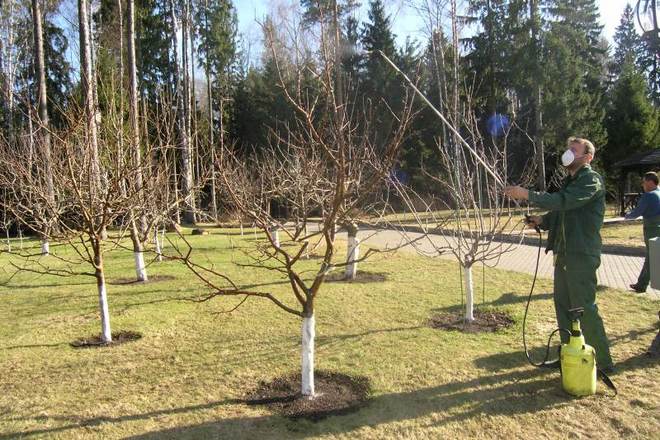

Apple tree processing.
Compliance with these simple recommendations will help you not harm, but benefit.
Life cycle
The population is usually dominated by females. The number of males can be 18–20% of the total number of insects. During the period of existence, one female lays about 100 eggs.
In autumn, the female lays eggs and dies immediately. Her shield serves as a shelter for eggs for the winter. When the temperature rises to + 10 ° C, the larvae crawl out of the shelter and crawl along.
Their fussy fast movements are caused by their short lifespan without a power source. Having found a suitable place, the larva sticks to and begins to feed intensively. They lose mobility, begin to become covered with fluff.
Within two weeks after hatching, the larvae molt and form their first scutellum. A month after that, an adult female is formed from the larvae.
Did you know? It is the females that do the main harm to the plants. Their saliva contains substances that harm plants.
Features of processing plants
Because of the shield, pests are very difficult to exterminate. Chemicals cannot get inside. Therefore, they are very often an auxiliary method of protection.
Physical processing with a metal scraper or brush cleans mature wood well. It is very convenient to walk along the bark with them in order to tear off both their shells and the pests themselves. There is no age limit, this mechanical method works equally on adults, larvae and eggs. In this way, seedlings and adult apple trees can be processed.
After carrying out these manipulations, you need to wash the wounds with soapy water. And if the damage is significant, the use of chemicals will be required. Moreover, they need to cultivate the land in the near-trunk circle.
Here are the types of drugs you should pay attention to:
- Phosbecid, which acts quickly and effectively, but is very toxic.
- Aktara, an effective, unpleasant odor treatment that also removes bees.
- Bitoxibacillin, a targeted biological agent that is safe for humans and other insects.
- 30 plus, a safe remedy that suppresses almost any pathogenic microflora, but only works in the spring.
If the lesion is very heavy, it will be easier to saw off the infected parts. It is very important to burn them right away.
The time when apple pest control is carried out
In the spring, apple trees are treated from the beginning of sap flow. The first treatment is done with dormant kidneys. In this case, the air temperature should be at least 5 degrees. Then processing is carried out during the period of bud swelling and processing just before flowering, in the so-called period of pink bud.
In summer, apple trees are sprayed when ovaries the size of a nut are formed on them until the time when the apples begin to color. By the time the crop ripens, it is undesirable to carry out processing.
In autumn, processing is carried out after harvest and before frost. Autumn processing will help get rid of pests hibernating in the soil and bark. After the leaves have fallen, processing can still be carried out. It is very important to remove and burn all fallen leaves in the fall. The earth around the trunks of apple trees is dug up to destroy the pests that winter in the soil.
Also in the fall, sanitary pruning is carried out, the trunks of apple trees are whitewashed. All treatments should be done when there is no rain.
Pest photo
In the photo, the scale insect on the apple tree has already spread and occupied most of the branches.
Harm inflicted
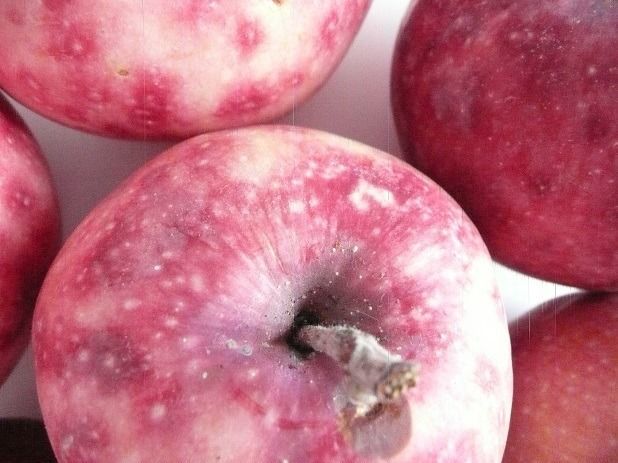

The Californian scale insect sticks to the trunk, branches, leaves and fruits of the plant and feeds on the cell sap. Such a neighborhood affects plants very badly: cracking of the bark, deformation and falling of leaves occurs, shoots are bent, fruits in places of damage are covered with brown spots. With significant damage, trees weaken and eventually die. The Californian scale insect is very adaptable to climatic changes, withstands temperatures from -35 ° C to + 43 ° C.
Questions and answers about the scale insect on the apple tree
Several issues are associated with the appearance and impact of pests:
- Is it possible to prevent infection? Of course, if you follow preventive measures and keep the garden in order.
- When will it be more effective to poison the pest? It is best to spray when the insect is in the larval stage. It is at this moment that they are defenseless. Eggs are not afraid of chemistry, and adults are hidden under a shield.
- Do folk remedies help? Some decoctions and infusions will help remove scale insects from apple trees. But their effectiveness will be sufficient only if the defeat is small.
Larvae
There are several forms of Californian scale insect larvae:
- The Vagabond is a newly hatched individual. It has an oblong-oval body, the length of which ranges from 0.2 to 0.3 mm. It has legs, eyes, a well-developed oral apparatus, the dimensions of which may exceed the length of the body.
- Nymph is the transitional stage of the larva, at which the formation of the chitinous shield takes place. The body takes on an oval shape. During this period of development, the Californian scale insect changes color from gray to dark black.

